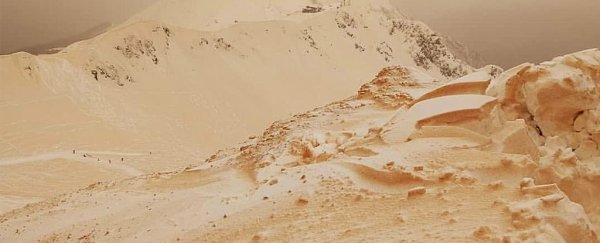A recent fall of really strange orange-tinted snow is making headlines after it swept across a swathe of Eastern Europe. Images on social media from Russia show mountainous landscapes tinged auburn, where usually they are pristine white.
Although it resembles what we might imagine snow on Mars to look like, the explanation is actually pretty simple.
According to the BBC, the orange colouration is caused by fine particles of sand being lifted from the Sahara into the atmosphere, travelling across the world and falling back to the ground mixed in with rain and snow.
It occurs once every five years or so - although this year's orange snow is particularly vibrant, due to a desert sandstorm that was so big it was seen in NASA satellite imagery travelling across the globe, CNN reports.
Social media users have posted photos of a ski resort in Sochi, Russia with its eerie orange slopes. The bizarre snow has also reportedly fallen on Bulgaria, Ukraine, Romania, and Moldova.
"There has been a lot of lifted sand or dust originating from North Africa and the Sahara, from sand storms which have formed in the desert," meteorologist Steven Keates from the UK Met Office told The Independent.
"As the sand gets lifted to the upper levels of the atmosphere, it gets distributed elsewhere. Looking at satellite imagery from NASA, it shows a lot of sand and dust in the atmosphere drifting across the Mediterranean. When it rains or snows, it drags down whatever is up there, if there is sand in the atmosphere."
Another view of the snow avalanche on Mt Elbrus, Caucasus, SW Russia yesterday, March 24. Note the reddish hue of snow due to deposited Saharan dust. Report via partners @cycloneorhodes pic.twitter.com/WW4Ucvuf7g
— severe-weather.EU (@severeweatherEU) March 25, 2018
It seems only fair that the Sahara comes to the snow after the snow came to the Sahara in December 2016- the first time since 1979. And it's done so again in 2017 and this January, too.
It's also much more benign than orange snow that fell on Siberia in 2007. Then, locals reported that the snow was foul-smelling and oily to the touch, possibly the result of chemical pollution.
This time, the orange snow is just a nice reminder of how connected we truly are by our planet's weather and climatic systems.
